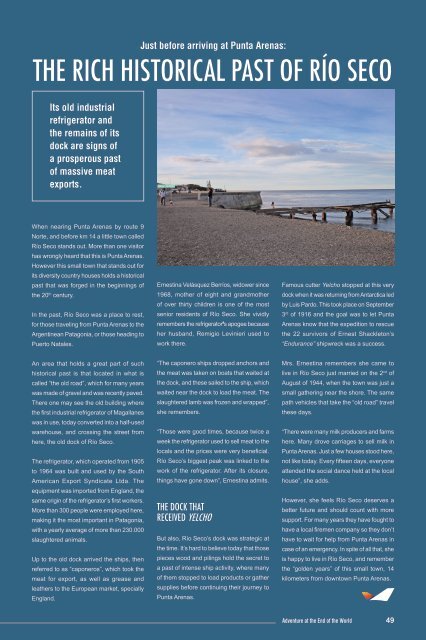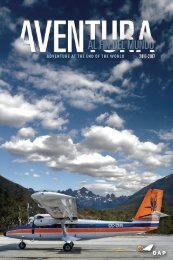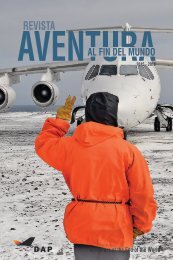REVISTA DAP AVENTURA 2014-2015
Los invitamos a conocer nuestra mirada, a través de esta nueva edición digital de revista "AVENTURA: Al Fin del Mundo", temporada 2014-2015. Cuéntanos qué te parece en facebook.com/grupodap _______/________ We invite you to know our world, in this new digital edition of "ADVENTURE: At the End of the World" 2014-2015 season. Tell us what you think on facebook.com/grupodap Enjoy!
Los invitamos a conocer nuestra mirada, a través de esta nueva edición digital de revista "AVENTURA: Al Fin del Mundo", temporada 2014-2015.
Cuéntanos qué te parece en facebook.com/grupodap _______/________
We invite you to know our world, in this new digital edition of "ADVENTURE: At the End of the World" 2014-2015 season.
Tell us what you think on facebook.com/grupodap
Enjoy!
Create successful ePaper yourself
Turn your PDF publications into a flip-book with our unique Google optimized e-Paper software.
Aventura al fin del mundo <strong>2014</strong> - <strong>2015</strong><br />
Just before arriving at Punta Arenas:<br />
THE RICH HISTORICAL PAST OF RÍO SECO<br />
Its old industrial<br />
refrigerator and<br />
the remains of its<br />
dock are signs of<br />
a prosperous past<br />
of massive meat<br />
exports.<br />
When nearing Punta Arenas by route 9<br />
Norte, and before km 14 a little town called<br />
Río Seco stands out. More than one visitor<br />
has wrongly heard that this is Punta Arenas.<br />
However this small town that stands out for<br />
its diversity country houses holds a historical<br />
past that was forged in the beginnings of<br />
the 20 th century.<br />
In the past, Río Seco was a place to rest,<br />
for those traveling from Punta Arenas to the<br />
Argentinean Patagonia, or those heading to<br />
Puerto Natales.<br />
Ernestina Velásquez Berríos, widower since<br />
1968, mother of eight and grandmother<br />
of over thirty children is one of the most<br />
senior residents of Río Seco. She vividly<br />
remembers the refrigerator’s apogee because<br />
her husband, Remigio Levinieri used to<br />
work there.<br />
Famous cutter Yelcho stopped at this very<br />
dock when it was returning from Antarctica led<br />
by Luis Pardo. This took place on September<br />
3 rd of 1916 and the goal was to let Punta<br />
Arenas know that the expedition to rescue<br />
the 22 survivors of Ernest Shackleton’s<br />
“Endurance” shipwreck was a success.<br />
An area that holds a great part of such<br />
historical past is that located in what is<br />
called “the old road”, which for many years<br />
was made of gravel and was recently paved.<br />
There one may see the old building where<br />
the first industrial refrigerator of Magallanes<br />
was in use, today converted into a half-used<br />
warehouse, and crossing the street from<br />
here, the old dock of Río Seco.<br />
The refrigerator, which operated from 1905<br />
to 1964 was built and used by the South<br />
American Export Syndicate Ltda. The<br />
equipment was imported from England, the<br />
same origin of the refrigerator’s first workers.<br />
More than 300 people were employed here,<br />
making it the most important in Patagonia,<br />
with a yearly average of more than 230.000<br />
slaughtered animals.<br />
Up to the old dock arrived the ships, then<br />
referred to as “caponeros”, which took the<br />
meat for export, as well as grease and<br />
leathers to the European market, specially<br />
England.<br />
“The caponero ships dropped anchors and<br />
the meat was taken on boats that waited at<br />
the dock, and these sailed to the ship, which<br />
waited near the dock to load the meat. The<br />
slaughtered lamb was frozen and wrapped”,<br />
she remembers.<br />
“Those were good times, because twice a<br />
week the refrigerator used to sell meat to the<br />
locals and the prices were very beneficial.<br />
Río Seco’s biggest peak was linked to the<br />
work of the refrigerator. After its closure,<br />
things have gone down”, Ernestina admits.<br />
THE DOCK THAT<br />
RECEIVED YELCHO<br />
But also, Río Seco’s dock was strategic at<br />
the time. It’s hard to believe today that those<br />
pieces wood and pilings hold the secret to<br />
a past of intense ship activity, where many<br />
of them stopped to load products or gather<br />
supplies before continuing their journey to<br />
Punta Arenas.<br />
Mrs. Ernestina remembers she came to<br />
live in Río Seco just married on the 2 nd of<br />
August of 1944, when the town was just a<br />
small gathering near the shore. The same<br />
path vehicles that take the “old road” travel<br />
these days.<br />
“There were many milk producers and farms<br />
here. Many drove carriages to sell milk in<br />
Punta Arenas. Just a few houses stood here,<br />
not like today. Every fifteen days, everyone<br />
attended the social dance held at the local<br />
house”, she adds.<br />
However, she feels Río Seco deserves a<br />
better future and should count with more<br />
support. For many years they have fought to<br />
have a local firemen company so they don’t<br />
have to wait for help from Punta Arenas in<br />
case of an emergency. In spite of all that, she<br />
is happy to live in Río Seco, and remember<br />
the “golden years” of this small town, 14<br />
kilometers from downtown Punta Arenas.<br />
Adventure at the End of the World<br />
49




